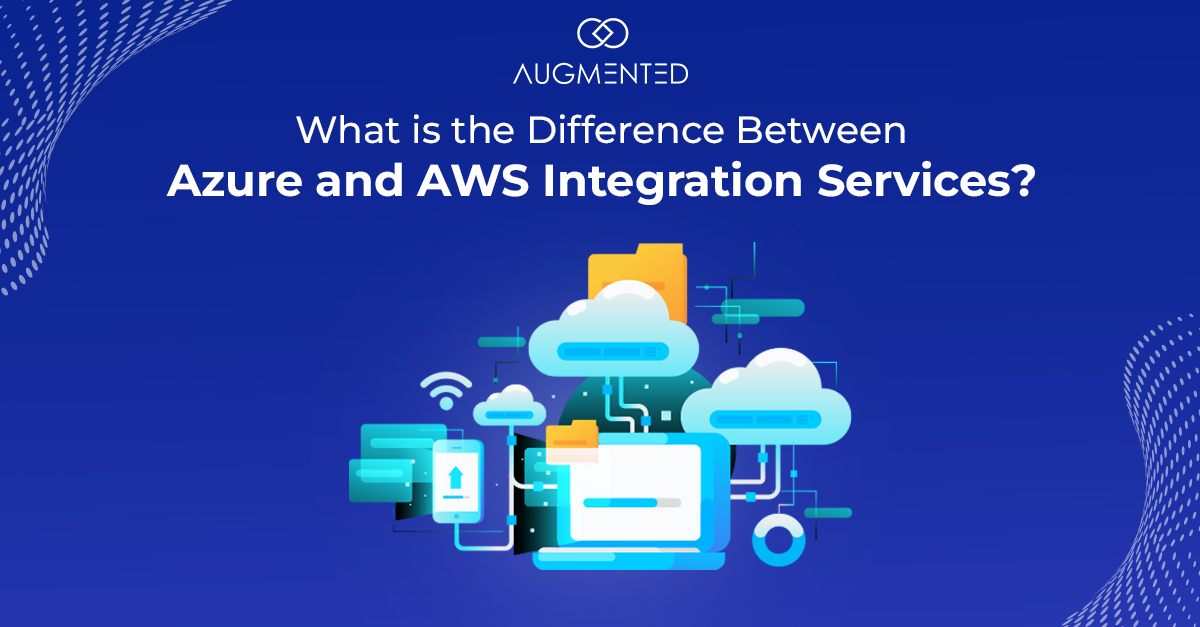Cloud computing for businesses is as irreplaceable in today’s scenario as an efficient workforce. By using it properly, you can save costs, monitor tasks, and manage operations effortlessly. It doesn't matter what the size of your organization is. If you can leverage this application integration solution wisely you will outpace your competitors and keep your business ahead of the time.
In this comparison, we will explore two prominent application integration software platforms: Azure and Amazon Integration Services. We will dig deeper into their respective components and functions. Then, analyze the differences so that you can make an informed decision about which one is the right fit for your needs.
What is Azure Integration Services?
Azure integration services include five tools that act as a bridge between on-premise services and cloud applications. They focus on securing APIs, making them accessible, streamlining workflows, connecting departments through communication, and automating and managing team tasks.
These application integration solution tools can be used separately or in different combinations to accomplish various organizational goals. You can achieve efficiency and consistency by having these five Azure integration services at your disposal.
Types of Integration Services Provided By Azure
Logic Apps
Logic Apps, an integral part of Azure Integration Services, is a cloud-based platform as a service that seamlessly automates workflows. Most B2B organizations rely on its capability to integrate applications and connect systems across on-premises, cloud, and hybrid environments.
Logic Apps is sought after for developing highly scalable integration services. For example, whenever a team member uploads a new file in Logic Apps, it will schedule and send an email notification, thus automating workflows.
Azure Service Bus
Service Bus is best used for messaging services. It offers three communication modes: queues, topics, and relays. While queues and topics handle one-way communication, relays take care of bi-directional communication. And it also integrates with other Azure services like Logic Apps, Stream, and Analytics.
B2C organizations rely on this Azure integration service to store and process a huge scale of messages. It allows receivers to process the messages at their own pace.
So essentially, it works as a connecting bridge between on-premises systems and cloud-based apps.
Azure Event Grid
Azure Event Grid works as a publish-service system that makes information accessible across varied Azure services and applications. Event Grid seamlessly plays the role of a reliable and capable route handler when it comes to managing built-in and custom events. It also builds event-driven serverless applications in the Azure cloud.
Azure Functions
Azure Functions is a serverless computing platform that allows developers to optimize infrastructure and write less code. Based on event triggering, the code deploys and executes without the need for a server infrastructure. Moreover, developers can use a myriad of programming languages such as C#, Java, TypeScript, and Python.
Azure integration services address various challenges when building apps, connecting devices, working with data, managing cloud setups, ensuring security, and more on Microsoft's Azure platform.
Azure API Management
As the name suggests, this Azure integration service manages all the APIs in one place. Additionally, it handles the tasks of securing and publishing APIs to the team as well as internal and external customers.
API management consists of three primary components:
- Azure Portal: Creates SQL databases, virtual machines, and app databases.
- Developer Portal: this is where developers can access the APIs.
- API Gateway: Securely manages and controls who can access APIs.
Many enterprises heavily rely on Azure Integration Services, as it effortlessly manages critical operations, ranging from data integration and enterprise messaging to system integration. It simplifies the work for developers and teams by handling complex tasks and streamlining them with essential components.
What is AWS Integration Services?
Application integration on Amazon Web Service is a set of services that helps different parts of application integration software work together more efficiently. This is especially useful in systems that are spread out across different locations.
One striking advantage of application integration on AWS is that it allows companies to concentrate on their important business objectives instead of spending too much time on routine or monotonous tasks.
There are five main groups or categories for the components of AWS application integration services:
Amazon API Gateway
API Gateway is a fully managed service that allows you to create, deploy, and manage APIs. API Gateway allows you to create APIs that connect to your applications and access AWS services or other external resources. It creates two different kinds of APIs: Restful APIs and WebSocket APIs. It also works effortlessly with other AWS integration services like lambda EC2 and S3.
Amazon Simple Queue Service
SQS is a comprehensive queuing service. It allows you to send, receive, and store messages across AWS integration services in large volumes. It supports two types of queuing mechanisms FIFO and standard queue.
Amazon Simple Notification Service
SNS takes care of the mass delivery of the app-to-app notifications. It facilitates various endpoints like SMS and Push notifications. With AWS integration services like notification service, you can count on scalable and reliable delivery of real-time notifications across various platforms and devices.
Amazon Simple Workflow Service
Simple workflow service works as a fully-fledged automated tracker that organizes assigned tasks to the team across different application components. While also tracking the progress and improvements. So it effortlessly eliminates the hassle of overseeing and managing the different schedules to manage task implementation.
AWS Lambda
AWS Lambda is a serverless computing platform. It works on an event-driven mechanism to run and execute backend code. It supports programming languages like Java, Nodejs, Python, and PowerShell.
AWS Step Functions
This Amazon integration service allows developers to create a series of visual workflows with the help of drag and drop feature. It empowers developers in coordinating and automating processes.
Face Off: Azure Vs Amazon Which One is for You?
Now that you know how each of these platforms' various components eases your burden. Let's compare their strengths and differences on different parameters so you can determine which one is made for your organization’s requirements.
Global Reach
While AWS integration services debuted first in 2006. Yet Azure has an edge over its presence in 60+ regions worldwide and 140 countries vs AWS’s 30 region presence worldwide. When you operate internationally with a widely spread employee you need to choose application integration software that is vastly available.
Cloud Storage
In AWS, the storage tier setting is object-oriented. This means that individual objects, such as files or data, can be configured to use different storage classes like S3 (Standard) or S3-IA (Infrequent Access) based on their access patterns or requirements.
In Azure, storage settings are done for the whole storage account. In AWS, the storage tier setting is object-oriented. Individual objects, such as files or data, can be configured to use different storage classes like S3 (Standard) or S3-IA (Infrequent Access) based on their access patterns or requirements.
AWS allows more granule control whereas Azure offers simpler management with less flexibility.
Security and Privacy
Since Azure has an edge in threat detection, it comprehensively covers aspects like firewalls, virtual machines, and databases. It seamlessly integrates with Power BI to create reports. Meanwhile, AWS has powerful encryption and key management.
Range of Services
On one hand, Azure provides an extensive range of services with incredible hybrid cloud capabilities. It also integrates well if you use Microsoft technologies in your organization.
On the other hand, AWS has advanced offerings like machine learning and the Internet of Things.
Ease of Use
While Azure is known for offering a user-friendly interface and easy integration. If an organization already works with a lot of Microsoft products, AWS can be considered more complex. AWS is known for having extensive documentation despite offering a wide range of services.
Pricing Model
Azure and AWS offer different payment approaches, both based on pay-as-you-use. Azure suits those using Microsoft products, while AWS offers savings plans for long-term cost-effectiveness. To find the more affordable option, examine service prices and usage before deciding.
Wrapping Up
Now that we have analyzed the components of application development and integration platforms thoroughly, you might be able to identify the strengths that can bring out the best for your organization. Even though both platforms offer excellent cloud solutions and provide ease of conducting operations, you also need to look within and measure your existing technology compatibility, scalability, and budget requirements to make a sound decision.
At Augmented Systems, we assist organizations of varying sizes and scales in navigating the data migration process swiftly within different cloud computing environments. Given our successful track record in managing cloud-to-cloud migrations over the years, we can provide the expertise needed to facilitate your migration seamlessly.





